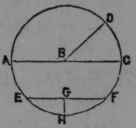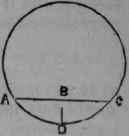The Circle And Its Sections
Description
This section is from the book "A Practical Workshop Companion For Tin, Sheet Iron, And Copper Plate Workers", by Leroy J. Blinn. Also available from Amazon: A Practical Workshop Companion For Tin, Sheet Iron, And Copper Plate Workers.
The Circle And Its Sections
Observations And Definitions
1. The Circle contains a greater area than any other plain figure bounded by the same perimeter or outline.
2. The areas of Circles are to each other as the squares of their diameters; any Circle twice the diameter of another contains four times the area of the other.
3. The radius of a circle is a Straight line drawn from the centre to the circumference, as BD, fig. 7.
4. The diameter of a circle is a Straight line drawn through the centre and terminated both ways at the circumference, as ABC.
5. A chord is a Straight line joining any two points of the circumference, as EF.
6. The Versed sine is a Straight line joining the chord, and the circumference as GH.
7. An arc is any part of the circumference, as AEH.
8. A Semicircle is half the circumference cut off by a diameter, as AHC.
9. A Segment is any portion of a circle cut off by a chord, as EHF.
10. A Sector is a part of a circle cut off by two radii, as CBD.
Fig. 7.

General Rules In Relation To The Circle
1. Multiply the diameter by 3.1416 the product is the Circumference.
2. Multiply the circumference by 31831, the product is the diameter.
3. Multiply the square of the diameter by .7854, and the product is the area.
4. Multiply the square root of the area by 1.12837, the product is the diameter.
5. Multiply the diameter by .8862, the product is the side of a Square of equal area.
6. Multiply the side of a square by 1.128, the product is the diameter of a circle of equal area.
Application Of The Rules To Practical Purposes
1. The diameter of a circle being 5 ft. 6 inches, required it circumference.
5.5 X 3 1416 = 17.27880 feet the circumference.
2. A straight line, or the circumference of a circle being 17.27880 feet required the circle's diameter corresponding there to.
17.27880 + .31831 = 5.5000148280 feet diameter-
3. The diameter of a circle is 9 3/8 inches; what is its area in square inches ?
9.3752 = 87.89, etc. X .7854 - 69.029, etc., inches the area.
4. What must the diameter of a circle be to contain an area equal to 69.029296875 square inches.
√ 69.02929, etc., = 8.3091 X 1.12837 = 9.375, etc., or 9 3/8 inches the diameter.
5. The diameter of a circle is 15 1/2 inches; what must each side of a square be, to be equal in area to the given circle ?
15.5 X .8862 = 13.73, etc., inches length of side.
6. Each side of a square is 13.736 inches in length, what must the diameter of a circle be to contain an area equal to the given square.
13.736 X 1.128 = 15.49 etc., or 15 1/2 inches the diameter.
Any chord and versed sine of a circle being given to find the diameter.
Rule. - Divide the sum of the squares of the chord and versed sine by the versed sine, the quotent is the diameter of corresponding circle.
7. The chord of a circle AC, fig. 8, equal 8 fret, and the versed sine, BD equal 1 1/2 feet, required the circles diameter.
82 + 1.52 = 66.25 ÷ 1.5 = 44.16 feet the diameter.
Fig. 8.

8. In the curve of a railway, I stretched a line 80 feet in length, and the distance from the line to the curve I found to be 9 inches, required the circles diameter.
802 + .752 = 640.5625 ÷ 2 = 820.28, etc., feet the diameter.
Continue to:


